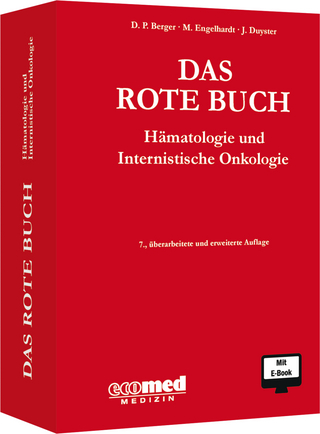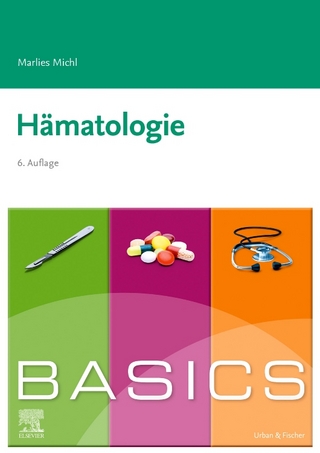Immune Thrombocytopenia (ITP)
UNI-MED (Verlag)
978-3-8374-1624-4 (ISBN)
1.Introduction18
2.History of ITP21
2.1.Introduction: What is thrombocytopenic bleeding?21
2.2.History of bleeding22
2.3.History of the pathogenesis of ITP23
2.4.History of management of patients with ITP23
2.5.The therapeutic translation of IVIg to other autoimmune disorders with similar
pathophysiology as in ITP25
2.6.Stimulation of platelet production by megakaryocytes26
2.7.Recent development of clinical research of ITP and new aspects of platelets themselves27
3.Basic immunology of ITP30
3.1.T cell and cytokine abnormalities in ITP30
3.2.B cell abnormalities31
3.3.Dendritic Cells (DC) in ITP31
3.4.Environmental factors in ITP32
3.5.Alternative modes of thrombocytopenia in ITP33
3.6.Conclusions33
4.Megakaryopoiesis in ITP36
4.1.Overview of normal thrombopoiesis36
4.2.Thrombopoiesis in ITP: evidence for accelerated platelet destruction38
4.3.Thrombopoiesis in ITP: evidence for impaired platelet production39
4.4.Megakaryopoiesis in ITP: evidence for direct roles of megakaryocytes40
5.Genetics of ITP45
5.1.Challenges in defining a genetic etiology of ITP45
5.2.Germline single-nucleotide variant (SNV) candidate gene approach45
5.3.Familial ITP45
5.4.Genome-wide association studies (GWAS)46
5.5.Future Directions47
6.Differential diagnosis of ITP: Inherited Thrombocytopenias48
6.1.Inherited Thrombocytopenias48
6.1.1.Clinical and laboratory peculiarities of inherited thrombocytopenias48
6.1.2.When to suspect inherited thrombocytopenias54
6.2.Differential diagnosis between ITP and inherited thrombocytopenias55
6.3.How to confirm the suspicion of inherited thrombocytopenia57
7.Secondary ITP59
7.1.Definition and limitation59
7.2.Etiology59
7.3.Diagnostic workflow60
7.4.Genetic panel62
7.5.Adult versus children62
7.6.Conclusions64
8.Standardization of definitions, terminology and outcome criteria:
a common language in ITP67
8.1.Criteria adopted by the IWG to harmonize terminology and definitions in ITP68
8.2.Primary and secondary ITP and diagnostic platelet count threshold68
8.3.Definition of the different phases and severity of the disease69
8.4.Therapeutic goals70
8.5.Definition of response71
8.6.Refractory ITP: definition, therapeutic goals and response assessment73
8.7.Clinical trial-adapted criteria for eligibility and outcome assessment75
8.8.Application of 2009 IWG proposals in real-word and need for revision75
8.9.Conclusions75
9.Decision making in the management of children with ITP80
9.1.A preference-sensitive decision80
9.2.Shared decision making81
9.3.Conclusion81
10.ITP in childhood: a problem-oriented review of the management84
10.1.Clinical presentation and diagnosis85
10.2.Prevention from and therapy of bleeding87
10.3.Non-intervention88
10.4.Intervention88
10.5.Splenectomy90
10.6.Conclusions90
11.ITP in adulthood93
11.1.Treatment of adult ITP94
11.1.1.General rules94
11.1.2.First-line therapy (initial treatment for newly diagnosed patients)94
11.1.3.Second-line therapy95
11.1.4.Other second-line therapies97
11.1.5.Patients failing multiple therapies99
11.1.6.New second- or third- or later-line therapies in the management of adults with ITP100
11.2.Conclusion101
12.Management of ITP in the elderly105
12.1.Diagnosis of ITP in the elderly105
12.2.Treating ITP in the elderly105
12.2.1.Intravenous immunoglobulins (IVIg)106
12.2.2.Corticosteroids106
12.2.3.Managing treatment failure and corticosteroid dependency106
12.2.4.Thrombopoietin receptor agonists106
12.2.5.Rituximab107
12.2.6.Fostamatinib108
12.2.7.Splenectomy108
12.2.8.Other medications108
12.2.9.Investigational therapies108
13.Chronic refractory ITP110
13.1.Practical Considerations of Refractory ITP110
13.2.Infection-related thrombocytopenia113
13.3.Drug-induced thrombocytopenia115
13.4.Secondary ITP115
13.5.Therapeutic approach116
13.5.1.General approach to refractory ITP117
13.5.1.1.Observation117
13.5.1.2.Standard therapy117
13.5.1.3.Therapy for refractory disease117
13.6.Outcomes and sequelae121
13.7.Summary122
14.Immune thrombocytopenia in pregnancy127
14.1.The differential diagnosis of thrombocytopenia during pregnancy127
14.2.ITP in pregnancy128
14.3.Conclusion130
15.Drugs in ITP: mechanisms of action133
15.1.Steroids133
15.2.Intravenous immunoglobulin (IVIg)134
15.3.Anti-D134
15.4.Rituximab (anti-CD20)135
15.5.Drugs that stimulate platelet production136
15.6.Conclusion137
16.Mechanism of action of high dose intravenous immunoglobulin in ITP141
16.1.Introduction141
16.2.Mononuclear phagocyte system (MPS) blockade142
16.3.Anti-idiotype antibodies144
16.4.IgG Fc region sialylation and the inhibitory Fc receptor (FcgRIIB)145
16.5.Cytokine modulation146
16.6.Neonatal Fc receptor (FcRn)147
16.7.Dendritic cells (DCs) and immunomodulation148
16.8.Current and emerging IVIg alternatives and mimetics for use in ITP149
16.9.Other mechanisms and conclusions151
17.Immune thrombocytopenia – the patients' perspective158
17.1.Patients “hate steroids”158
17.2.Rituximab159
17.3.Patients try to avoid splenectomy159
17.4.Patients and Thrombopoetin-Receptor Agonists (TRAs)159
17.5.Other therapies160
17.6.The quagmire of modern medicine160
17.7.What patients really want162
17.8.Conclusions162
18.Quality of Life as a treatment endpoint for patients with ITP164
18.1.Introduction164
18.2.Assessment of Health Related Quality of Life in ITP164
18.2.1.HRQoL in Adults164
18.2.2.HRQoL in Children165
18.3.ITP symptoms in HRQoL165
18.3.1.Bleeding and Bruising166
18.3.2.Fatigue167
18.4.Impact of treatments on HRQoL167
18.4.1.First-line agents167
18.4.2.Second-line therapies168
18.5.Conclusion169
19.Fatigue as a treatment end point in ITP172
19.1.How do we define fatigue172
19.2.How can we assess fatigue172
19.3.How much of a problem is fatigue in ITP173
19.4.Why does fatigue develop in ITP176
19.5.Cytokines and Immune dysregulation177
19.6.How do we manage the ITP patient with fatigue179
19.7.Improving the Standard of Care180
19.8.Conclusion181
20.Guidelines for using ITP management guidelines186
20.1.Guidelines for management of ITP187
20.2.Pros and cons of guidelines187
20.3.Evidence based vs. patient centered management188
21.State of the Art and future Considerations of ITP190
21.1.Heterogeneity of ITP190
21.2.Unknown etiology of ITP192
21.3.Immunomodulation in inflammatory and autoimmune disorders192
21.4.Platelet stimulation by thrombopoietin receptor agonists (TPO-RA) of megakaryopoiesis193
21.5.Future progress and the question of adequate management of ITP194
22.List of abbreviations201
Index203
| Erscheinungsdatum | 21.05.2022 |
|---|---|
| Reihe/Serie | UNI-MED Science |
| Verlagsort | Bremen |
| Sprache | englisch |
| Maße | 175 x 245 mm |
| Gewicht | 495 g |
| Einbandart | gebunden |
| Themenwelt | Medizinische Fachgebiete ► Innere Medizin ► Hämatologie |
| Medizin / Pharmazie ► Medizinische Fachgebiete ► Onkologie | |
| Schlagworte | Immune Thrombocytopenia • ITP • thrombocytopenic purpura |
| ISBN-10 | 3-8374-1624-0 / 3837416240 |
| ISBN-13 | 978-3-8374-1624-4 / 9783837416244 |
| Zustand | Neuware |
| Haben Sie eine Frage zum Produkt? |
aus dem Bereich




